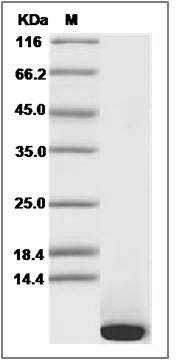-
Product Name
Mouse EGF/Epidermal Growth Factor recombinant protein
- Documents
-
Description
EGF is the founding member of the EGF-family of proteins. Members of this protein family have highly similar structural and functional characteristics. EGF contains 9 EGF-like domains and 9 LDL-receptor class B repeats. Human EGF is a 6045-Da protein with 53 amino acid residues and three intramolecular disulfide bonds. As a low-molecular-weight polypeptide, EGF was first purified from the mouse submandibular gland, but since then it was found in many human tissues including submandibular gland, parotid gland. It can also be found in human platelets, macrophages, urine, saliva, milk, and plasma. EGF is a growth factor that stimulates the growth of various epidermal and epithelial tissues in vivo and in vitro and of some fibroblasts in cell culture. It results in cellular proliferation, differentiation, and survival. Salivary EGF, which seems also regulated by dietary inorganic iodine, also plays an important physiological role in the maintenance of oro-esophageal and gastric tissue integrity. EGF acts by binding with high affinity to epidermal growth factor receptor on the cell surface and stimulating the intrinsic protein-tyrosine kinase activity of the receptor. The tyrosine kinase activity, in turn, initiates a signal transduction cascade that results in a variety of biochemical changes within the cell - a rise in intracellular calcium levels, increased glycolysis and protein synthesis, and increases in the expression of certain genes including the gene for EGFR - that ultimately lead to DNA synthesis and cell proliferation.
-
Protein name
Pro-epidermal growth factor
-
Protein short names
EGF; AI790464; URG; HOMG4
-
Uniprot ID
P01132
-
Gene Name
Egf
-
Source/Expression Host
Yeast
-
Expression Plasmid/cDNA
A DNA sequence encoding the mouse EGF (P01132) (Asn977-Arg1029) was expressed and purified.
-
Protein Species
Mouse
-
Molecular weight
The recombinant mouse EGF consists of 53 amino acids and predicts a molecular mass of 6 KDa. It migrates as an approximately 6 KDa band in SDS-PAGE under reducing conditions.
-
Purity
> 95 % as determined by SDS-PAGE
-
Activity
Measured in a cell proliferation assay using Balb/3T3 mouse embryonic fibroblast cells.
The ED50 for this effect is typically 20-100 pg/mL. -
Validations

Mouse EGF / Epidermal Growth Factor Protein SDS-PAGE
Related Products / Services
Please note: All products are "FOR RESEARCH USE ONLY AND ARE NOT INTENDED FOR DIAGNOSTIC OR THERAPEUTIC USE"
